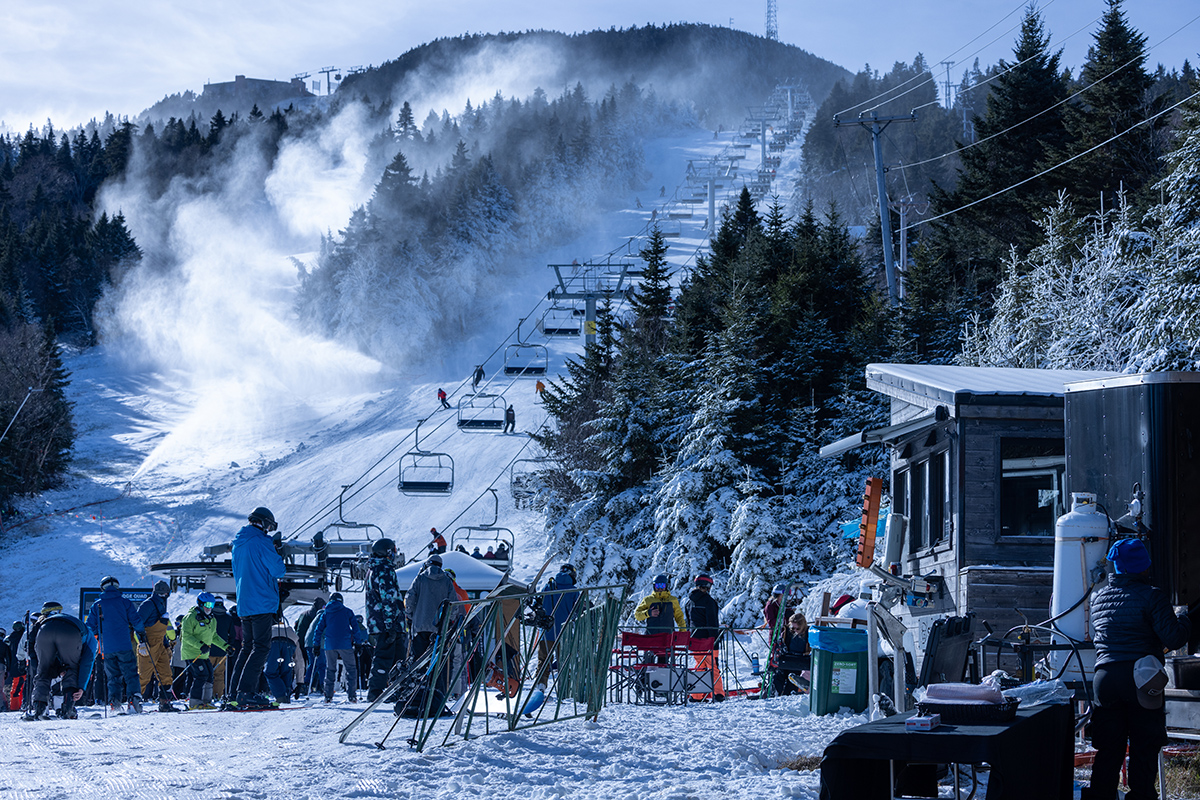By Karen D. Lorentz
Editors note: This is the first of a three-part series that explores how innovations at Okemo and Killington enabled them to become successful ski resorts that also contributed to the growth of the ski industry in Vermont, the East, and the nation.
Vermont’s Killington Resort and Okemo Mountain have been, over the last half-century and into the 21st, two of the nation’s most successful ski resorts. They have also been leaders in the ski industry, developing many innovations and enhancements that engendered a better skiing and riding experience, including investing in robust snowmaking operations, which is crucial early season and after thaws like the region saw this past week.
The early days, innovative beginnings
Killington was created by a group of dedicated skiers headed by Preston Leete Smith, an ambitious 24-year-old entrepreneur who never stopped pushing the envelope to create a better ski experience. A dedicated skier, he was instrumental in the development of better learning techniques and easier learning terrain. By getting more people into skiing, he helped drive skiing’s rapid growth in the 1950s and 1960s.
Okemo, under the ownership of early investors from the town of Ludlow, started the real estate revolution in American skiing by selling homesites on land it owned and soon boasted a rapidly expanding mountainside of ski chalets and condominiums, which in turn earned it the loyalty of families and profits that could be poured back into mountain expansion. The convenience of ski in/out vacations homes also helped drive the popularity of skiing and the ski industry and Okemo led the pack in this regard.
During the 1950s, the demand for more resorts in the East grew as the number of skiers accelerated beyond all predictions after World War II. The classic resorts like Stowe-Mt. Mansfield and Mad River in Vermont and Mt. Cranmore in New Hampshire were stuck in pre-war thinking that saw skiing as a sport for the “elite” rather than as a huge pyramid with a mass of bus riders as the base and chalet owners at the top. At the same time, there were notable start-up failures like Vermont’s Snow Valley and other areas struggling and dying young because they didn’t have the “right stuff.”
Killington and Okemo, located 16 miles from each other, both broke the mold—they did have the right stuff. While each took a different route, innovation and outside-the-box thinking drove both resorts to the top.
Each area was started on a shoestring with their founders selling shares of stock ($10 share) to fund development. Okemo opened Jan. 31, 1956, with two Poma lifts, and, at the time, the 6,207-foot Red was the longest Poma in the country! With a 20-cent ticket required for each ride on the Yellow Poma and three tickets needed for a single ride on the Red, Okemo was also very expensive, as one disgruntled skier wrote to the board. Okemo instituted a $5 day ticket ($58 in today’s dollars) which was still expensive for that time.
Killington opened Dec. 13, 1958, operating a record four Poma lifts its first year. It was a humble start with a chicken coop for a ticket booth, a WW II vintage Quonset hut for a base lodge (replaced the following year by the state), and an eight-seat outhouse. Interestingly, Killington’s founders had paid $250 for each share of stock they purchased versus giving themselves shares and leaving the risk of the venture to the people who bought stock. They also gave a lifetime pass with the purchase of four shares ($1,000) which would be $11,599 in today’s dollars.
While Okemo took to selling lots for trailside villages, a move that would endear it to skiers as the ultimate in family convenience, Killington embraced a pioneering R&D approach with similar fervor.
Each also adopted pioneering approaches to ski instruction. Killington initiated the Graduated Length Method (GLM) which was based in part on the concept of the Shortee short ski which Cliff Taylor had invented and used to teach beginners. Killington was the only area that responded to Ski magazine’s invitation to try its idea out. Working in concert with Ski, Killington tested the idea of using three different ski lengths to teach parallel skiing from the start and then developed a teaching progression using all three that brought thousands to learn to ski at Killington.
Okemo became one of the first areas to offer Walter Foeger’s Natur Teknik, a teaching method developed by Foeger at Vermont’s Jay Peak. It entailed skiing parallel from the start but on the long skis of the day!
The most significant similarity between the two areas was that each had big dreams and the mountain terrain that would make it possible to attract both those new to skiing and the experts. Neither was founded or operated by rich entrepreneurs; rather it was people who loved skiing. What ultimately made the difference in their becoming the successes they are today were the dreams, drive, and dedication of their leaders and workers.
Next week we’ll take a look at the rise of Okemo in Part 2.




